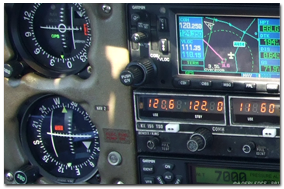Flight Rules in the United Kingdom
Two basic types of weather conditions exist in aviation, which of course means more acronyms: VMC (Visual Meterological Conditions) and IMC (Instrument Meterological Conditions) are mutually exclusive categories designed to ensure safety in the air whatever the weather. In simple terms VMC is defined as when the pilot is in sight of the ground, can use the horizon as a visual reference to maintain the aircraft's attitude and is able to maintain separation from other air traffic and terrain visually - that is, without help from the aircraft's instruments. IMC on the other hand describes conditions where poor visibility makes it necessary to reply primarily on instruments to maintain attitude and keep the aircraft and its occupants clear of potential hazards.
The pilot operating in VMC must fly according to Visual Flight Rules, or VFR, in other words mostly 'eyes-outside', keeping a constant lookout to maintain a safe distance from conflicting aircraft and obstacles. Under IMC conditions a pilot must instead follow Instrument Flight Rules or IFR, meaning that he or she must hold an Instrument rating, having acquired the skills required for piloting the aircraft using avionics to compensate from the absence of visual cues. This arrangement is to be found all across the world, although the precise rules vary slightly in different territories.
IR(R) (Instrument Rating, restricted)
Previously known as the IMC Rating, the IR(R) allows the PPL licence holder to operate in IMC conditions within the United Kingdom whilst remaining outside of the very tightly controlled 'Class A' airspace. Whilst not allowing quite the same degree of freedom to which commercial and military pilots with full instrument ratings are entitled, the IR(R) means being able to fly on those days when conditions are not conducive to VFR flight - and will also necessarily teach you the more demanding skills of Radio Navigation - a fascinating area of study in itself. The IR(R) rating requires a minimum of 15 hours flight training with an instructor, 29 hours ground school, one written exam and a flight test. MAK Aviation is also able to offer both Multi-Engine IR(R) and IR renewals in a Gulstream Cougar twin - please see Our Prices for further details.
► Read more about the IR(R) on the CAA website



Night Rating
The night rating is a most useful fallback when you just need to get from A to B after dark - or maybe you're running a little late returning from a sumptuous lunch at your favourite French airfield - and also a prerequisite for professional licences. This rating allows the PPL or LAPL holder to fly at night under Visual Flight Rules ('night' being defined by the Civil Aviation Authority as from 30 minutes after sunset to 30 minutes before sunrise). The requirements for the night qualification are 5 hours of overall night flying, of which at least 3 are under dual instruction, and at least 1 hour of dual night navigation. This training must include 5 take offs and full-stop landings at night as well as some theoretical study including learning about night-time specific human performance factors, meterological phenomena and aircraft lighting systems. There is no exam or written test required to gain this rating, therefore the cost to the student can be simply calculated as 5 hours of dual instruction in the aircraft of their choosing.
► Read more about the Night Rating on the CAA website
MAK AVIATION FLIGHT SCHOOL
London Elstree Aerodrome | Borehamwood | Herts WD6 3AW | tel: 020 8236 9308
© MAK Aviation 2019
